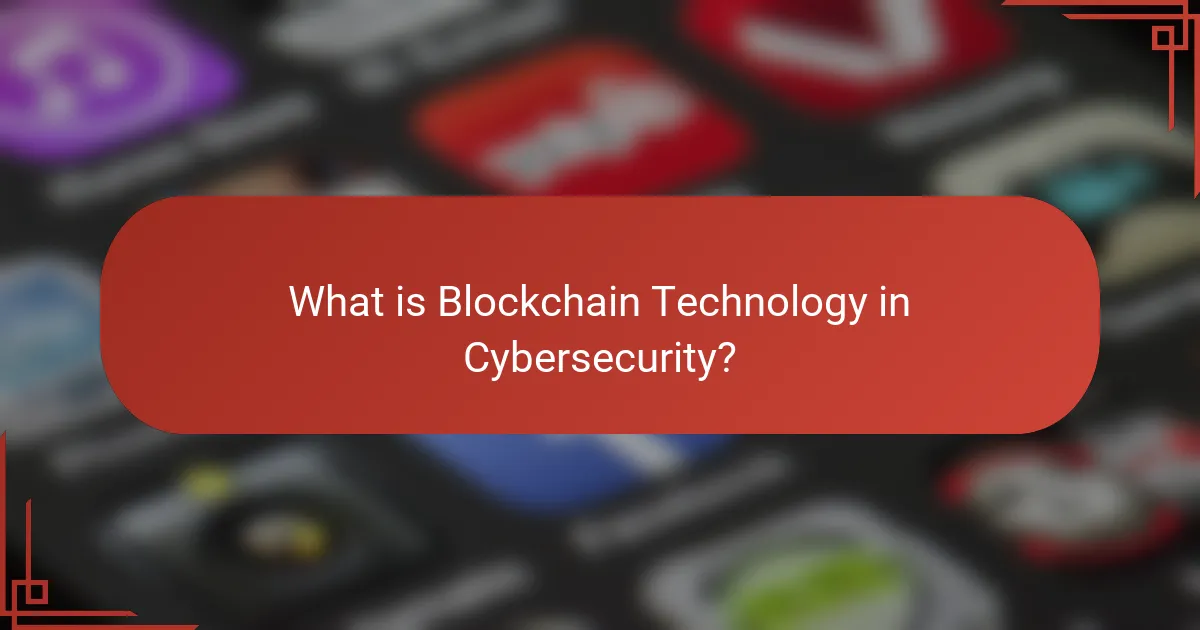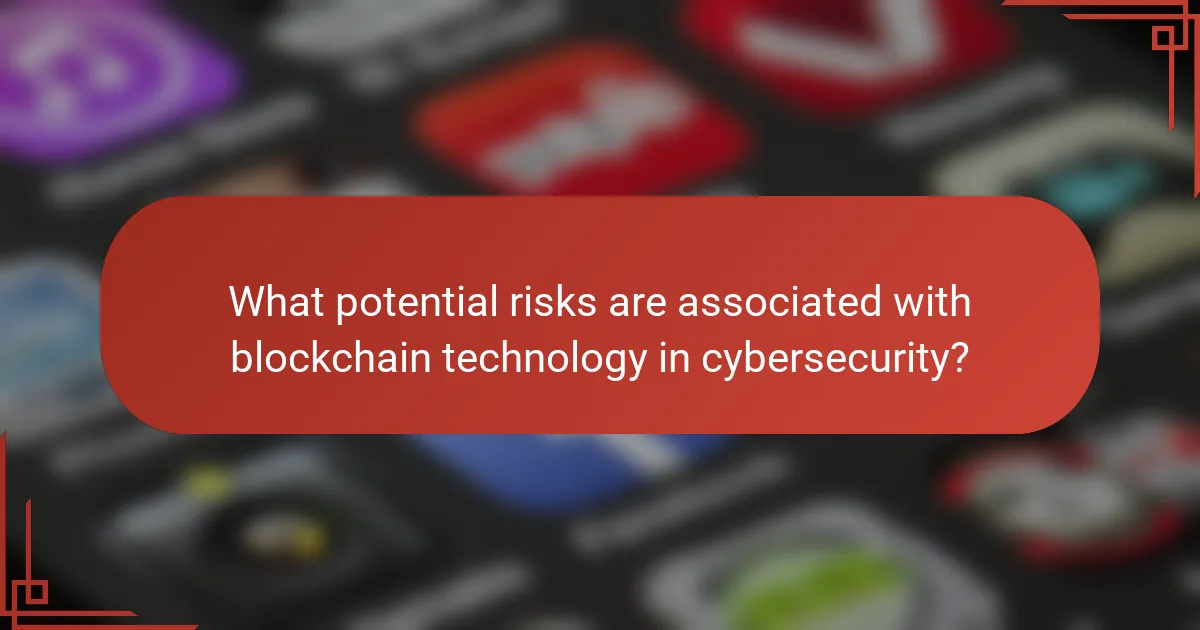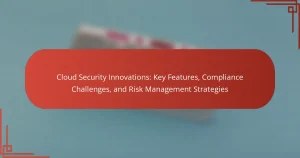Blockchain technology, a decentralized digital ledger system, plays a significant role in enhancing cybersecurity by providing secure transaction validation and data integrity. This technology operates on a network of computers that record transactions in an immutable chain, making unauthorized alterations difficult. While blockchain offers advantages such as increased transparency and reduced cybersecurity risks, it also presents potential challenges, including data immutability, vulnerabilities in smart contracts, and regulatory issues. Organizations can leverage blockchain to improve security protocols and automate processes, ultimately reducing security breaches significantly.

What is Blockchain Technology in Cybersecurity?
Blockchain technology in cybersecurity is a decentralized digital ledger system that enhances data security. It operates on a network of computers that validate and record transactions securely. Each transaction is grouped into a block and linked to the previous block, creating an immutable chain. This structure makes it difficult for malicious actors to alter data without detection.
Blockchain’s encryption and consensus mechanisms ensure that only authorized users can access or modify information. According to a report by the World Economic Forum, blockchain can reduce cybersecurity risks by increasing transparency and trust among parties. The technology has been implemented in various sectors, including finance and healthcare, to protect sensitive information.
How does blockchain technology enhance cybersecurity?
Blockchain technology enhances cybersecurity through its decentralized and immutable nature. It secures data by distributing it across a network of computers. This makes it difficult for hackers to alter or corrupt information. Each transaction is recorded in a block and linked to the previous one. This creates a chain that is transparent and verifiable. Additionally, blockchain employs cryptographic techniques to protect data integrity. Unauthorized access is minimized because users must have permission to alter data. According to a study by Accenture, blockchain can reduce cybercrime costs by up to 30%. This demonstrates its effectiveness in enhancing cybersecurity.
What are the fundamental principles of blockchain that support cybersecurity?
The fundamental principles of blockchain that support cybersecurity include decentralization, immutability, and transparency. Decentralization reduces the risk of single points of failure. It distributes data across multiple nodes, making it harder for attackers to compromise the entire network. Immutability ensures that once data is recorded, it cannot be altered or deleted. This property protects against data tampering and unauthorized changes. Transparency allows all participants to verify transactions, fostering trust and accountability. These principles collectively enhance security by making unauthorized access and fraud significantly more challenging.
How does decentralization contribute to enhanced security?
Decentralization enhances security by distributing data across multiple nodes. This distribution reduces the risk of a single point of failure. In a centralized system, if one server is compromised, the entire system is vulnerable. Decentralized systems require attackers to breach multiple nodes simultaneously. This makes unauthorized access significantly more difficult. Furthermore, blockchain technology employs cryptographic techniques to secure data. Each transaction is linked and immutable, preventing tampering. According to a study by the MIT Media Lab, decentralized systems can improve resilience against cyber attacks. The study highlights that decentralized networks are less likely to suffer from widespread breaches.
What unique advantages does blockchain technology offer in cybersecurity?
Blockchain technology offers decentralized data storage, enhancing cybersecurity. This decentralization reduces the risk of data breaches. Each transaction is recorded in a secure, immutable ledger. This immutability prevents unauthorized alterations to data. Blockchain’s encryption methods provide robust data protection. These methods ensure that only authorized users can access information. Additionally, transparency in blockchain allows for easier auditing of transactions. This transparency helps in detecting fraudulent activities quickly.
How does blockchain improve data integrity and authenticity?
Blockchain enhances data integrity and authenticity through its decentralized and immutable nature. Each transaction is recorded in a block and linked to previous blocks, forming a secure chain. This structure prevents unauthorized alterations, ensuring that data remains consistent over time.
Additionally, blockchain employs cryptographic techniques to secure data. Each block contains a unique hash, which is generated based on its contents and the hash of the previous block. This makes tampering easily detectable, as any change would alter the hash and break the chain.
The transparency of blockchain also contributes to data authenticity. All participants in the network can access the same data, which fosters trust and accountability. According to a study by the World Economic Forum, blockchain can reduce data manipulation risks significantly in various sectors, including finance and supply chain management.
These features collectively ensure that data stored on a blockchain is reliable and trustworthy.
What role does transparency play in blockchain-based cybersecurity solutions?
Transparency is crucial in blockchain-based cybersecurity solutions. It ensures that all transactions and data exchanges are visible and verifiable by all participants. This visibility helps to build trust among users, as they can independently confirm the integrity of the data. Moreover, transparency allows for the detection of unauthorized changes or malicious activities in real-time. According to a study by the MIT Media Lab, transparency in blockchain systems can reduce fraud and enhance accountability. By providing a tamper-proof record, blockchain technology enhances security and mitigates risks associated with data breaches.
How does blockchain technology facilitate secure identity management?
Blockchain technology facilitates secure identity management by providing a decentralized and immutable ledger for storing identity data. This technology allows users to control their personal information without relying on a central authority. Each identity is represented as a unique cryptographic key, ensuring that only authorized users can access their data. Transactions on the blockchain are encrypted and time-stamped, which enhances security and traceability. The decentralized nature of blockchain reduces the risk of data breaches, as there is no single point of failure. Furthermore, smart contracts can automate identity verification processes, increasing efficiency. Studies have shown that blockchain can significantly decrease identity fraud by providing transparent verification methods.

What potential risks are associated with blockchain technology in cybersecurity?
Blockchain technology poses several potential risks in cybersecurity. One major risk is the immutability of data, which can prevent the correction of errors or fraudulent entries. Additionally, smart contracts can have vulnerabilities that attackers may exploit. The decentralized nature of blockchain can lead to a lack of accountability among users. Furthermore, private keys, essential for accessing blockchain assets, can be lost or stolen, leading to irreversible losses. Network attacks, such as 51% attacks, can compromise the integrity of the blockchain. Lastly, regulatory challenges may arise, as the technology often operates in a legal gray area.
What are the common vulnerabilities in blockchain systems?
Common vulnerabilities in blockchain systems include smart contract flaws, 51% attacks, and insufficient security measures. Smart contract flaws can lead to unintended exploits. For example, the DAO hack in 2016 resulted from a vulnerability in its smart contract, leading to a loss of $50 million. A 51% attack occurs when a single entity gains control of over half the network’s hashing power. This can allow manipulation of transactions and double spending. Insufficient security measures, such as weak private key management, can lead to unauthorized access and theft. According to a report by CipherTrace, over $1.9 billion was stolen from cryptocurrency exchanges in 2020 due to various vulnerabilities. These vulnerabilities highlight the need for robust security protocols in blockchain systems.
How can smart contract flaws impact cybersecurity?
Smart contract flaws can significantly impact cybersecurity by introducing vulnerabilities that malicious actors can exploit. These flaws may lead to unauthorized access, loss of funds, or data manipulation. For instance, the infamous DAO hack in 2016 resulted from a vulnerability in a smart contract, leading to a loss of $60 million worth of Ether. Additionally, poorly written smart contracts can allow for reentrancy attacks, where an attacker repeatedly calls a function before the initial execution completes. This can drain funds from the contract, compromising its integrity. Moreover, if a smart contract interacts with other contracts, flaws can propagate and affect the entire ecosystem. These security issues highlight the necessity for rigorous testing and auditing of smart contracts before deployment.
What are the risks of scalability in blockchain networks?
Scalability in blockchain networks poses several risks. These risks include network congestion, which occurs when the number of transactions exceeds the network’s processing capacity. High transaction fees can arise as users compete for limited space in blocks. This can lead to delayed confirmations, frustrating users and potentially driving them away.
Centralization risk increases as some nodes may handle more transactions than others. This can undermine the decentralized nature of blockchain. Security vulnerabilities may also emerge as scaling solutions are implemented, potentially exposing the network to attacks.
Moreover, interoperability issues can arise when different blockchains attempt to communicate. This can hinder the overall effectiveness of blockchain solutions. Finally, the complexity of scaling solutions can lead to implementation challenges, increasing the likelihood of errors.
How do regulatory and compliance challenges affect blockchain in cybersecurity?
Regulatory and compliance challenges significantly impact blockchain in cybersecurity by creating barriers to adoption. These challenges include varying regulations across jurisdictions that can hinder the implementation of blockchain solutions. For instance, strict data protection laws may conflict with blockchain’s transparency features. Compliance costs can also be high, as organizations must invest in legal expertise to navigate complex regulations. Additionally, uncertainty surrounding the regulatory landscape can deter investment in blockchain technologies. According to a report by the World Economic Forum, 77% of executives believe that regulatory uncertainty is a major barrier to blockchain adoption. Thus, regulatory and compliance challenges can slow the integration of blockchain in cybersecurity, limiting its potential benefits.
What legal considerations must organizations address when implementing blockchain technology?
Organizations must address several legal considerations when implementing blockchain technology. These include data privacy laws, such as the General Data Protection Regulation (GDPR) in the EU. Organizations must ensure that personal data is handled in compliance with these regulations. Additionally, intellectual property rights must be considered, as blockchain can impact ownership and rights management.
Regulatory compliance is critical, especially in sectors like finance and healthcare. Organizations must understand how blockchain intersects with existing regulations in these industries. Smart contracts also raise legal questions regarding enforceability and liability.
Furthermore, jurisdictions can complicate legal matters, as blockchain operates across borders. Organizations need to be aware of the varying legal frameworks in different countries. Finally, anti-money laundering (AML) and know-your-customer (KYC) regulations must be adhered to, particularly if the blockchain involves cryptocurrency transactions.
How can organizations mitigate compliance risks associated with blockchain?
Organizations can mitigate compliance risks associated with blockchain by implementing robust governance frameworks. These frameworks should include clear policies for data management and regulatory adherence. Regular training for employees on compliance requirements is essential. Organizations should also engage with legal experts to interpret relevant regulations. Conducting risk assessments can identify potential compliance gaps. Utilizing blockchain analytics tools can enhance transparency and traceability. Establishing partnerships with regulatory bodies can facilitate better compliance understanding. Continuous monitoring of blockchain transactions ensures adherence to compliance standards.

How can organizations effectively implement blockchain technology for cybersecurity?
Organizations can effectively implement blockchain technology for cybersecurity by integrating decentralized ledgers into their security protocols. This integration enhances data integrity and transparency. Blockchain’s immutable nature protects against data tampering. Each transaction is recorded in a secure, distributed network. This makes unauthorized alterations nearly impossible.
Furthermore, organizations can utilize smart contracts to automate security processes. Smart contracts execute predefined actions when specific conditions are met. This reduces human error and speeds up response times to security threats.
According to a report by IBM, blockchain can reduce security breaches by up to 50% due to its robust encryption and decentralized architecture. This statistic underscores the effectiveness of blockchain technology in strengthening cybersecurity measures.
What best practices should organizations follow when adopting blockchain for cybersecurity?
Organizations should follow several best practices when adopting blockchain for cybersecurity. First, they must conduct a thorough risk assessment to identify potential vulnerabilities. This assessment should analyze existing systems and how blockchain can enhance security. Second, organizations should ensure compliance with relevant regulations and standards. Adhering to these guidelines mitigates legal risks and promotes trust. Third, they should invest in training for staff on blockchain technology and its implications. Educated employees are critical to effective implementation. Fourth, organizations must choose the right blockchain platform that aligns with their security needs. The platform should support necessary features like encryption and access controls. Fifth, they should implement robust governance frameworks to oversee blockchain operations. Clear policies help maintain accountability and security. Finally, continuous monitoring and auditing of the blockchain system are essential. Regular checks can identify and address issues promptly. These practices collectively enhance the security posture of organizations using blockchain.
How can organizations ensure the security of their blockchain implementations?
Organizations can ensure the security of their blockchain implementations by adopting best practices and robust security measures. They should conduct thorough risk assessments to identify potential vulnerabilities. Implementing strong encryption techniques is essential to protect data integrity and confidentiality. Regular software updates and patch management help mitigate security threats. Organizations must also establish clear access controls to limit permissions based on user roles. Conducting regular audits and [censured] testing can identify weaknesses before they are exploited. Training employees on security awareness is crucial to prevent human errors that may compromise security. According to a report by IBM, 95% of cybersecurity breaches are due to human error, highlighting the importance of employee training.
What steps can be taken to educate staff about blockchain and cybersecurity risks?
To educate staff about blockchain and cybersecurity risks, organizations should implement structured training programs. These programs should cover the fundamentals of blockchain technology and its implications for cybersecurity. Workshops can facilitate hands-on learning and practical applications. Regular updates on emerging threats related to blockchain should be communicated to staff. Interactive sessions can engage employees and encourage questions. Providing access to online resources can supplement formal training. Case studies of real-world breaches involving blockchain can illustrate risks effectively. Lastly, fostering a culture of cybersecurity awareness is essential for ongoing education.
What are the future trends of blockchain technology in cybersecurity?
Future trends of blockchain technology in cybersecurity include enhanced data integrity, improved identity management, and decentralized security solutions. These trends stem from blockchain’s immutable nature, which ensures data cannot be altered retroactively. Enhanced data integrity helps organizations maintain accurate records and reduce fraud. Improved identity management allows for secure verification processes, reducing identity theft incidents. Decentralized security solutions distribute data across multiple nodes, minimizing single points of failure. According to a report by Gartner, by 2025, 75% of organizations will adopt blockchain technology for secure transactions. This statistic underscores the growing reliance on blockchain in cybersecurity.
How might advancements in blockchain technology shape future cybersecurity strategies?
Advancements in blockchain technology will enhance future cybersecurity strategies by providing decentralized security solutions. Blockchain’s inherent characteristics include immutability, transparency, and distributed consensus. These traits allow for secure data storage and verification without a single point of failure. For example, the use of blockchain can reduce the risk of data breaches by making unauthorized alterations easily detectable. A study by IBM indicates that blockchain can decrease cybersecurity costs by up to 30% through improved data integrity and fraud prevention. Furthermore, smart contracts can automate and enforce security protocols, ensuring compliance and reducing human error. As organizations increasingly adopt blockchain, cybersecurity frameworks will evolve to integrate these technologies for more robust protection.
What emerging technologies could complement blockchain in enhancing cybersecurity?
Artificial intelligence (AI) and machine learning (ML) can complement blockchain in enhancing cybersecurity. AI algorithms analyze vast amounts of data for threat detection. They identify patterns and anomalies that indicate potential cyber threats. Machine learning models improve over time, adapting to new threats.
Quantum computing also poses a significant enhancement. It can potentially break traditional encryption methods. However, it can also lead to the development of quantum-resistant encryption techniques. These techniques would secure blockchain networks against future quantum attacks.
Another emerging technology is the Internet of Things (IoT). IoT devices can leverage blockchain for secure data transmission. This integration enhances the security of connected devices and reduces vulnerabilities.
Finally, decentralized identity solutions can enhance user authentication. They allow users to control their own identity data. This reduces the risk of identity theft and unauthorized access.
These technologies collectively strengthen the cybersecurity landscape when integrated with blockchain.
What practical tips can organizations use to leverage blockchain technology in cybersecurity?
Organizations can leverage blockchain technology in cybersecurity by implementing decentralized identity management. This approach enhances security by allowing users to control their own identities on the blockchain. Additionally, organizations can utilize smart contracts to automate security protocols. Smart contracts execute predefined actions when specific conditions are met, minimizing human error.
Furthermore, organizations should consider using blockchain for secure data sharing. Blockchain ensures data integrity and confidentiality through its immutable ledger. Another practical tip is to adopt blockchain for auditing purposes. The transparent nature of blockchain allows for real-time tracking of changes and access, facilitating compliance and accountability.
Lastly, organizations can collaborate with blockchain security experts. Engaging with specialists can help in designing robust blockchain-based security solutions tailored to specific needs. Implementing these strategies can significantly enhance an organization’s cybersecurity posture.
Blockchain technology serves as a decentralized digital ledger system that significantly enhances cybersecurity by securing data through its immutable and transparent nature. This article explores the unique advantages of blockchain, such as improved data integrity, secure identity management, and reduced cybersecurity risks, while also addressing potential vulnerabilities, including smart contract flaws and regulatory challenges. Key principles like decentralization and transparency are examined, alongside practical tips for organizations looking to implement blockchain solutions effectively. Additionally, emerging technologies that complement blockchain in enhancing cybersecurity are discussed, providing a comprehensive overview of its role in modern security strategies.


